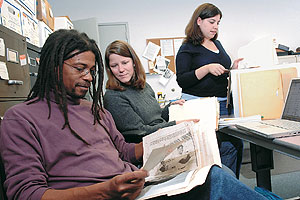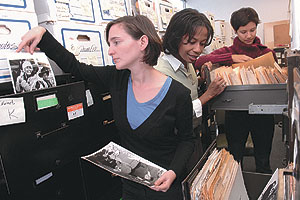Ph.D. students assisting with uncovering hidden collections in city archives — University Library’s poetry, jazz archives next
By Julia MorseNews Office
  Darryl Heller, a Ph.D. student in History (left to right, top photo), Christina Petersen, a Ph. D. student in Cinema & Media Studies, and Monica Mercado, a Ph.D. student in History, review files at the Chicago Defender offices. Their work, made possible by a grant from the Andrew W. Mellon Foundation, will organize and preserve an archive of more than 100,000 archival photographs. Ph.D. students Mollie Godfrey (English), Allyson Hobbs (History) and Melissa Barton (English) organize photos in the archives of the Chicago Defender. The students have been assisting Jacqueline Goldsby, Associate Professor in English Language & Literature and the College, with Mapping the Stacks, an archival project at the newspaper that began in July. Earlier in 2005, the students assisted with manuscript and moving image archives at two other locations, including the DuSable Museum of African-American History. | |
During the next three years, important and yet hidden, historical collections in Chicago will be revealed, thanks to a $617,000 grant from the Andrew W. Mellon Foundation. The University will embark on the Uncovering New Chicago Archives Project that aims to improve access to two groups of University collections and Chicago-area archives that are tied to African-American history.
“Library strategic goals and faculty interests came together on a shared desire to uncover hidden collections,” said Judith Nadler, Director of the University Library.
At the University, the project will organize and describe the archives of contemporary poetry and the Chicago Jazz Archives located in the Special Collections Research Center of the University Library. It also will include archives at the DuSable Museum of African-American History, the Chicago Defender, and the Vivian G. Harsh Collection of Afro-American History & Literature located in the Woodson Regional Library.
The UNCAP builds on and expands Mapping the Stacks, an archival project that Jacqueline Goldsby, Associate Professor in English Language & Literature and the College, has been directing since she started it in 2005. That year, Goldsby and a group of students began working with manuscripts in the Harsh Collection and with the DuSable Museum’s manuscript and moving image archives.
In June this year, the Mellon Foundation gave Goldsby a $49,000 Officer’s Grant for additional archival work. It allowed her and the team of eight Ph.D. students to begin sorting and organizing more than 100,000 historical images in the Chicago Defender’s photo archives. They began this work in July and have been working exclusively with the photo archives at the Chicago Defender, a publication Goldsby calls, “the most important African-American newspaper of this century.” The students are wrapping up this phase of their Mapping the Stacks work this fall at the paper.
Beginning in January 2007, any remaining work done by students at the newspaper and the museum will then be funded by the UNCAP grant, as it expands Mapping the Stacks. Sixteen University students and several members of the faculty will work collaboratively through the end of 2009 with archivists at the University, the DuSable Museum and the Harsh Collection, in addition to the Chicago Defender.
The final result will be a Web site providing access to descriptions of the contents of the archives at all locations. The site will allow students, researchers and scholars at the University, in the community and around the world to discover what is available by searching across all collections for relevant materials.
In the meantime, individuals at the University who spearheaded the project are thrilled at how well it is unfolding. “The interconnection was flawless. It’s rare when all these interests and all these parties come together so smoothly with exactly the same objective,” said Goldsby. “The thrilling part is how those at the Library and at the Mellon Foundation have really all respected the necessity of this,” she said.
 | |
Planning for the project began last fall and winter at the Library, and discussions with the Mellon Foundation followed shortly thereafter. The UNCAP grant money was officially given for the project in mid-September. During the first year of the UNCAP, Goldsby will continue working with students on Mapping the Stacks at the first three archive sites. In the second and third years, the project also will focus on the Regenstein’s jazz and contemporary poetry collections. A professional archivist will be hired to assist with this process.
Travis Jackson, Professor in Music, and Robert von Hallberg, the Helen A. Regenstein Professor in English Language & Literature and the College, will provide guidance to the work on the Chicago Jazz Archives and the contemporary poetry archive, respectively.
“This has long-term benefits for the larger world of scholarship,” said Alice Schreyer, Assistant Director for Special Collections & Preservation and Director of the Special Collections Research Center at the Library. “But also, and equally as important, this project will offer our faculty and our students first-hand insight into history as well as active engagement in our community.”
Schreyer noted that without the Mellon Foundation’s grant, the University’s jazz and contemporary poetry archives would be unknown and unusable for years to come.
“Right now, we have a very minimal level of control of those archives; we know what we have, but it’s not user-friendly,” she said. “Without the grant, the world would be deprived of this history, of this wealth of information.”
In addition to the Mellon Foundation’s support, eight Ph.D. students have been rolling up their sleeves and digging into primary sources. Schreyer noted that the students involved in the work have gained a great deal, as well. “This project has opened the students’ eyes—moving them from book-based learning to a lab of sorts. The students working on Mapping the Stacks are Melissa Barton, Doron Galili, Mollie Godfrey, Darryl Heller, Moira Hinderer, Allyson Hobbs, Monica Mercado and Christina Petersen.
Hobbs, who is working toward her Ph.D. in History, worked with her fellow students and Goldsby at the Chicago Defender this past summer.
“The Mapping the Stacks project provides graduate students with a rare opportunity to access key collections pertaining to African-American life in Chicago and to become familiar with the inner workings of archives, museums and historic black institutions,” Hobbs said.
Petersen, who is studying for her Ph.D. in Cinema and Media Studies, worked with Hobbs on the project this past summer and said the experience was truly enriching.
“The life of a graduate student often by necessity shrinks to the confines of academia at the expense of our involvement in the community surrounding the University,” Petersen said. “What I enjoy most about my work with Mapping the Stacks is that I am able to bridge the gap between studying film history and drawing attention to film as a moving embodiment of social history, through my involvement in a community greater than the University.”
The end result of all the hard work will be accessibility, outreach, usability and availability of archive files at the University, the Chicago Defender, the DuSable Museum and the Harsh Collection.
“This is such a wonderful opportunity to work with faculty, students and the community,” Nadler said. “Together, we are creating a resource that will inspire and inform now and into the future.”
![[Chronicle]](/images/sidebar_header_oct06.gif)